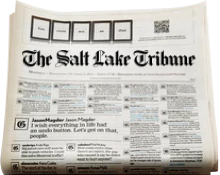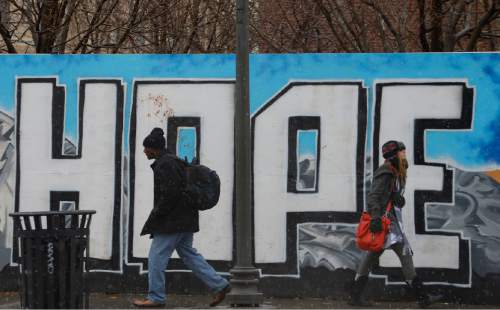This is an archived article that was published on sltrib.com in 2016, and information in the article may be outdated. It is provided only for personal research purposes and may not be reprinted.
[Video: A smart guy with a Brit accent explains the cultural meaning of zombies.]
San Francisco • The tour guide at the front of the streetcar was definitely not on the payroll.
Not just because San Francisco Muni streetcars don't generally have tour guides. But because this fellow was not exactly giving the tourist-friendly spiel.
"I can't wait till the stock market crashes again," said the man in the front seat. "That's when the rents will finally go down. It'll be like scurrying cockroaches."
He did have a good handle on the local landscape.
"Riding these streetcars, you'll go right by the world headquarters of Twitter, Uber, Airbnb," he accurately announced. "And Facebook is just a little ways down there. Those companies don't make anything except make it more expensive to live here."
Tiny homes in San Francisco easily go for more than $1 million. Landlords ask, and get, $2,400 a month for a studio apartment. In the more trendy neighborhoods like Bernal Heights or North Beach, rents have recently shot up to something topping $8,000 a month.
And that explains one of the most memorable sights visitors see in San Francisco.
I say memorable for visitors because the locals don't seem to notice. In the same way that natives of any city seem oblivious to grand old buildings, modern skyscrapers and majestic bridges, they ignore, walk around, all but step over the large number of homeless people who live on the streets.
A few of the homeless ask for money. Some offer services, including directions for obviously confused tourists. One smart fellow in multiple layers of ponchos and a Niners ball cap attached himself to our party and helped us negotiate Golden Gate Park.
"It's my hustle," he said. And he was good at it. Knowledgeable and entertaining.
But, on the streets of San Francisco, most of the homeless folks just seem to sit there, or lie on the sidewalk.
Yes, Salt Lake City's homeless problem is getting so bad that people are actually doing something about it. But so far it has mostly been contained — more by a sad version of market forces than by any plan — to a relatively small area near Pioneer Park.
Except for the lonely fellow who knocked on my back door, more than two miles from the park, a couple of weeks ago asking for a handout. When I suggested he check out the local homeless shelter, he just shivered.
In San Francisco, the homeless seem to be scattered over a larger area, all over the commercial and public square parts of downtown. So many of them that they no longer shock, surprise or draw much pity from tourists or from the well-dressed movers and shakers who power-walk by.
Back to the guy on the streetcar.
"You know what all those zombie shows are about, don't you?" he asked. "You know, 'The Walking Dead' and all those? They're about the homeless. And the war that's coming."
Maybe. It's been suggested by people who aren't ranting on public transit.
The metaphor works when you realize how each of us real people could become a zombie at any minute if we're downsized, divorced or get sick. But it breaks down when, instead of drawing fusillades of vigilante gunfire, the modern urban homeless are just ignored.
We saw a squad of EMTs and police officers gathered around one such soul on the sidewalk on Market Street, the main commercial drag. He seemed motionless. Not sure who called 911, who decided that individual was worth official attention when none of the others were.
The lesson of the San Francisco real-life zombie movie is one Salt Lake City must take to heart. Especially as we seek Facebook and other high-tech industry outposts whose most immediate effect will be to force up the already unreachable rents charged by so many property owners.
We must take action right away, either with Salt Lake County Mayor Ben McAdams' plan or something else that we can put together quickly. Because the real threat is not that war will break out between the zombies and the people who, but for the grace of continued employment, might be zombies.
The threat is that there will be a horrible kind of peaceful coexistence where the homeless are just kind of there, unnoticed, neither threatened nor threatening. That their suffering literally under our noses will bother us less than the things we need to do to reduce their number: Raise the minimum wage. Make access to health care truly universal. Realize that affordable housing will never be provided in sufficient amounts by the private sector alone.
We shouldn't be ashamed of what offends us, but of what we are able to put up with.
George Pyle, a Tribune editorial writer, was crushed to find out there is no historic marker for the site where Admiral Kirk parked his Klingon bird of prey in Golden Gate Park. gpyle@sltrib.com



